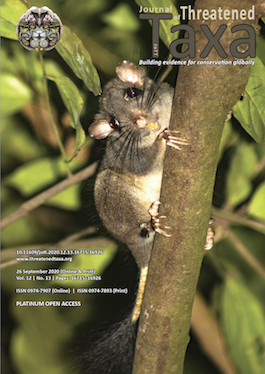Indigenous uses and traditional practices of endemic and threatened Chilgoza Pine Pinus gerardiana Wall. ex D.Don by tribal communities in Kinnaur District, Himachal Pradesh, northwestern Himalaya
DOI:
https://doi.org/10.11609/jott.6117.12.13.16891-16899Keywords:
Endemic, indigenous uses, threatened, tribal communitiesAbstract
Pinus gerardiana is an endemic and threatened pine of northwestern Himalaya. It is the only conifer in India which is traded for its nuts. In addition to subsidiary source of income to Kinnaura tribes, it is an important part of ecology, traditions, and culture of Kinnaur District of Himachal Pradesh. Kinnaura are one of the largest ethnic groups of Himachal Pradesh famous for their own unique traditions, culture, and lifestyle. In view of this, the present study was conducted to document the indigenous uses and traditional practices of Pinus gerardiana (Chilgoza Pine) by Kinnaura tribes of Himachal Pradesh. At present, destructive harvesting practices of collection of Chilgoza nuts, fuelwood, torchwood, timber, and needles of Chilgoza Pine is not only causing serious damage to trees but also affecting its natural regeneration and future crop production. Thus, this continuous loss of Chilgoza Pine will affect the livelihood of the tribal communities and ecosystem of the area in near future. Hence, population assessment, ecological niche modeling, awareness programmes, and sustainable harvesting of cones are suggested for its conservation.
References
Anonymous (1969). Wealth of India, Raw Materials 8: 65–66.
Farjon, A. (1984). Pines: Drawing and Description of Genus Pinus. Antiquarian Booksellers, Association of America Pub, New York, USA, 220pp.
Farjon, A. (2013). Pinus gerardiana. The IUCN Red List of Threatened Species 013:e.T34189A2850009. Downloaded on 17 June 2020. https://doi.org/10.2305/IUCN.UK.2013-1.RLTS.T34189A2850009.en
Johnsingh, A.J.T., G.S. Rawat, P.V. Satyakumar & J. Kuar (1998). Prioritization of area for biodiversity conservation of alpine zone-1Trans and Greater Himalaya in India. Biodiversity Conservation Prioritization Project in India, WWF, New Delhi, 212–224pp.
Kumar, R., G.S. Shamet, O.P. Chaturvedi, R.K. Avasthe & C. Singh (2013). Ecology of Chilgoza pine (Pinus gerardiana Wall.) in dry temperate forest of North West Himalaya. Ecology, Environment & Conservation 19(4): 1063–1066.
MAIL (2012). Chilgoza Pine Forest Conservation and Restoration Plan-Draft Report.
Mittermeier, R.A., P.L. Gil, M. Hoffman, J. Pilgrim, T. Books, C.G. Mittermeier, J. Lamoreux & G.A.B.D. Fonseca (2004). Hotspots Revisited: Earth’s Biologically Richest and Most Endangered Terrestrial Ecoregions, Conservation International, Washington.
Negi, S.S. (2002). Chilgoza or Neoza pine-an important NTFP of the tribal areas of Kinnaur District in H.P. Journal of Non-Timber Forest Products 9 (1/2): 70–72.
Peltier, R. & V. Dauffy (2009). The Chilgoza of Kinnaur. Influence of the Pinus gerardiana edible seed market chain organization on forest regeneration in the Indian Himalayas. Fruits (Paris) 64(2): 99–110.
Samant, S.S., U. Dhar & L.M.S. Palani (1998). Medicinal plants of Indian Himalaya: Diversity, Distribution, Potential Value. Nanital Gyanodaya Parkashan.
Samant, S.S., S. Pant, M. Singh, M. Lal, A. Singh, A. Sharma & S. Bandari (2007). Medicinal plants in Himachal Pradesh, North Western Himalaya, India. International Journal of Biodiversity Science & Management 3: 234–251.
Sehgal, R.N. & P.K. Khosla (1986). Chilgoza Pine: The Threatened Social Forestry Tree of Dry Temperate Himalaya. National Symposium on Research in Social Development, 1–2 January.
Sehgal, R.N. & P.K. Sharma (1989). Chilgoza: The Endangered Social Forestry Pine of Kinnaur. Technology Bullettin, FBTI, 6.
Singh, R.V., D.C. Khanduri & K. Lal (1973). Chilgoza Pine (Pinus gerardiana) regeneration in Himachal Pradesh. Indian Forester 99(3): 126–133.
Tondon, J.C. (1963). Revised working plan for the Kinnaur and Kochi Forest (Upper Satluj Valley), Himachal Pradesh. Vol-2. Office of the Chief Conservator of Forests. Working Plan Circle, Himachal Pradesh, India, 284pp.
Troup, R.S. (1921). The Silviculture of Indian Trees. Vol-3, Oxford University Press, 1195pp.
Published
Issue
Section
License
Authors own the copyright to the articles published in JoTT. This is indicated explicitly in each publication. The authors grant permission to the publisher Wildlife Information Liaison Development (WILD) Society to publish the article in the Journal of Threatened Taxa. The authors recognize WILD as the original publisher, and to sell hard copies of the Journal and article to any buyer. JoTT is registered under the Creative Commons Attribution 4.0 International License (CC BY), which allows authors to retain copyright ownership. Under this license the authors allow anyone to download, cite, use the data, modify, reprint, copy and distribute provided the authors and source of publication are credited through appropriate citations (e.g., Son et al. (2016). Bats (Mammalia: Chiroptera) of the southeastern Truong Son Mountains, Quang Ngai Province, Vietnam. Journal of Threatened Taxa 8(7): 8953–8969. https://doi.org/10.11609/jott.2785.8.7.8953-8969). Users of the data do not require specific permission from the authors or the publisher.





